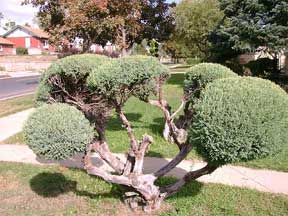Don’t ever let anyone tell you that evergreens shouldn’t be pruned – even a tree pruning service. Pines, junipers and other evergreens can, and should, be pruned. The time and procedure to use will, of course, determine the results that you can expect.
First, remember that pruning in early spring before the new growth comes out is most desirable. Any bare branches that may result from the pruning shears will be hidden by new growth. You can also prune at other times. Late summer is good if you have a lot of pruning to do because evergreens have a period of growth in the fall as well as in the spring.

Fall growth is not as great as spring growth. Cutting back branches that have grown away from the general shape of the plant can be done in early summer or late fall. The evergreens will then go through the summer and winter in a neat and orderly shape.
The procedure to use when removing branches or twigs from evergreens will vary with the type of plant you are working on. Evergreens with whorled branches (pines, spruces. fir) can be grouped into one category, and all the others (juniper, yew, arbor-vitae, chamaecyparis, hemlock) into another.
Most evergreens with whorled branches are large growing, forest tree types of plants. One exception is the Mugo Pine. It has a shrubby growth habit.
The Mugo Pine and other evergreens with whorled branches are usually pruned to keep their shape compact. For this reason pruning is confined to the removal of buds or short terminal shoots.
To Keep Height Down
If you don’t want your tree to get any higher than it already is, you can remove the center bud from the main leader of the tree. However, if you want the tree to get taller but at a slower rate, don’t remove the terminal bud because it is the source of the new leader. Instead, shorten the length of the terminal shoot when the new needles on it are about one half developed (usually in June).
Always leave at least two inches of the shoot. The young cells in the shoot divide and form new buds. Small side branches can be removed if the plant is already too wide for its setting. Remember, though, that the new growth is usually from terminal buds, and if all of them are removed, you won’t get any more growth from that area.
Evergreen plants that do not have whorled branches are easy to prune because new growth comes from lateral buds. Pruning them into hedge form does not harm them. However, you probably do not always want a plant that is tightly sheared. As a matter of fact, the formal hedge type of plant training does not complement our modern architecture.
Pruning Other Types
If you try to maintain the natural shape of the plant when you prune, there will be no need to worry about ruining its shape because the nature of all plants is to grow back to their original form regardless of how they are pruned. All you need to do is make cuts at various points on different stems. Some cuts should be made closer to the main part of the plant than others. You can use a sharp knife or pruning shears to make the cuts.
Upright forms of junipers and arbor-vitae which have grown too tall for their settings can be topped to any height desired. Shape the upper foliage to a point, and in a growing season, the topped appearance will not be evident.
Pruning Rules
- Don’t be afraid to prune. If the plant needs pruning, and you cut off all the live foliage, dig the plant out and plant a variety that is appropriate for the setting.
- Prune a little every year. This eliminates the need for drastic pruning which will harm the appearance of the plant until the new growth covers bare spots.
- Always cut off more foliage than you feel is necessary. In other words, when the plant has made its new growth, it should be at the desired height.
- Always leave some new foliage.
- Don”t remove the lower branches of any evergreen. No new branches will develop and the leggy effect is not desirable.
- If you want some greens for decorative use, you can take some from your evergreens. Don’t use hemlock or spruce. They drop their needles almost as quickly as you get the clippings indoors.
Contributed by H.R. Kemmerer
